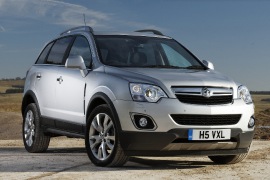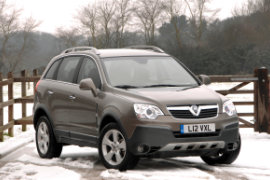VAUXHALL Antara Models/Series Timeline, Specifications & Photos
First production year: 2007
Engines: Diesel, Gasoline
Body style: SUV (Sports Utility Vehicle)
After five years on the market and successfully emerging from the world financial crisis, the Antara received a well-deserved facelift along with upgraded engines.
The Antara was built on a platform developed by GM Korea, and it was so good that it became a world car. It was sold in Australia, the U.S., Africa, and Europe. In the UK market, it was sold under the Vauxhall badge, like all the European Opels from those times.
The refreshed vehicle sported a more angular look with new angular headlights. They contrasted with the upper grille's shape, which was rounded. Yet, the front fascia looked good for those times. The Antara sported a pair of foglights surrounded by chromed trims on the lower bumper. A new set of turn signals found their way onto the door mirrors. In addition, there was a new design for the taillights in the rear and repositioned reversing lights.
Inside, the Antara offered five seats as standard, and the carmaker noticed that customers were not very excited about the seven-seat version, so it dropped it. However, it focused on the dashboard, which featured a new dashboard design, with lines carried over from its compact sibling, the Astra. Moreover, a new infotainment unit with a screen placed atop the center stack made its way into the Antara options list.
Under the hood, Vauxhall installed only Euro5 engines, which have been mandatory since 2009. They offered a 10 percent increase in displacement compared to the non-facelifted version and enough power to move the all-wheel drive vehicle around.
Sharing most of its underpinnings and powertrains with the Chevrolet Captiva, the Vauxhall Antara was a compact crossover SUV produced between 2006 and 2015.
Just like the twin sister Open Antara, the crossover was built on the Theta platform and offered seating for 5, while the Chevrolet Captiva could accommodate up to 7 occupants.
The model was sold under different names depending on the market, such as Opel Antara in Europe, Holden Captiva MaXX in the Australasia and as Saturn Due in Canada and the US.
Resembling the Opel Antara GTC Concept presented in 2005 at the Frankfurt Motor Show, the final version featured a stylish exterior design with a sporty and athletic look.
Inside, the driver-oriented cockpit was practical and looked well, with its design getting close to that of a more luxurious sedan. Other eye-catching details inside the cabin were three large round air vents and a distinctively shaped handbrake grip.
Space-wise, the new Antara offered a roomy cabin with great legroom and headroom for all occupants. The trunk was a good size offering a transport volume of 370 liters, 865 liters with the folded bench and up to 1420 liters when loaded to the roof.
Safety was also considered with front and side airbags, head curtain airbags, three-point seat belts and head restraints, as well as belt-face limiters and seat-belt pre-tensioners.
The Vauxhall Antara was available in three trim levels: E, S and the flagship SE.
The entry-level Antara came with four-wheel-drive, ESP, air-conditioning, fog lights and 17-inch alloys. With the S trim level, the buyers got electronic climate control, heated front seats, a trip computer, cruise control, a rear seat center armrest, 18-inch alloys, automatic headlights and wipers, as well as chrome door handles.
The top-of-the-range SE came with leather upholstery, Bluetooth connectivity, xenon headlamps, parking sensors, a tyre pressure monitoring system, electro-chromatic dimming rear-view and door mirrors, as well as a DVD-based satellite navigation system.

